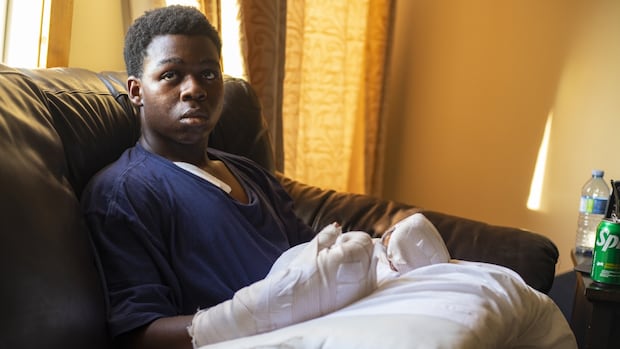How do kiwi and oyster sound? People are using AI to dream up new culinary creations

The Current23:45Strawberries with ketchup? Chefs turn to AI for new ideas
Larry McCabe wanted to truly test the digital pallet of artificial intelligence. So he pitted AI against real-world chefs.
The prompt was simple enough. He asked ChatGPT to come up with unique canapé and cocktail pairings. He asked the same of his staff at Cafe Bouffon in Stratford, Ont.
Then the French eatery held a tasting event, while keeping people in the dark about who dreamed up what.
“We wanted to do something provocative, and the question was, ‘Will our next master chef emerge from artificial intelligence? Or, is taste a uniquely human phenomenon?'” McCabe told The Current host Matt Galloway.
McCabe is one of many people in the food and beverage industry experimenting with AI-based technology, such as ChatGPT, to create new recipes from new food combos to unique brews. But people in the industry say AI isn’t a replacement for those who make food and drink.
Instead, they say it’s a way to get the creative juices flowing and aid busy chefs, brew masters and coffee roasters. And the use of new technology is something restaurant owners are hungry for.
At McCabe’s tasting event, human-made pairings won for the most part. But there was one pairing where the AI came out on top.
The AI’s beet-brined eggs with yolk mousse and dill topped the chef’s beet carpaccio with goat cheese mousse.
AI a time saver, restaurateur says
Isaiah Archer asked ChatGPT early last year to brew up a new beer for Whistle Buoy Brewing as a marketing gimmick. The plan was to play on people’s fascination with artificial intelligence, but it turned into Robo Beer Hazy Pale Ale.
“I’m not going to say it was, like, this is better than what we could do, because I don’t think that’s true,” said Archer.
“But it was interesting to see how quickly you can come up with something that was up to the level.”
Archer, who is a partner and director of marketing with Whistle Buoy Brewing in Victoria, says they had already planned on brewing a new hazy pale ale recipe. But with ChatGPT in the news, they figured they’d give the AI a chance at brewing.
“We said, ‘Create a recipe for a hazy pale ale — light, fluffy, tropical,'” said Archer.
“Maybe 10 or 15 seconds later, there was a full recipe and then full brewing instructions in front of us. So just the speed in which it was able to do that was quite alarming.”
It wasn’t perfect. It got some of the ratios wrong, Archer said. But the brew master was able to tinker with the recipe to make it work.

Archer says that since brewing the Robo Beer, they haven’t used AI for their recipes. And while Whistle Buoy’s approach was mostly a marketing move, some business owners are turning to AI to make their business more efficient.
McCabe says the restaurant has been using AI to generate ideas when going through a menu change. He says they change it up two or three times a year, and this gives them a place to start.
Chefs are busy, he says, so having a place to start can save valuable time.
“We were using it as a tool to generate a bunch of ideas and then narrow that down into things that were worth pursuing. And I think that that actually was very effective,” said McCabe.
Fast food companies are investing big in AI and robots to do many of the repetitive tasks of restaurant workers, especially in the face of a post-pandemic worker shortage.
Changing industry
The food and beverage industry is experimenting with AI across the globe. In Finland, Kaffa Roastery launched a coffee blend developed by artificial intelligence called AI-conic.
Chains such as Domino’s, White Castle and McDonald’s have experimented with technology such as automated pizza makers, burger flippers and fry fryers.
FoodPairing is a tech company that uses AI to help the industry develop unique flavour combinations. For example, It paired kiwi and oyster together.
While they may seem like an odd combination, the company’s co-founder, Bernard Lahousse, says the AI-derived idea works.
FoodPairing comes up with all sorts of unique combinations, like strawberry and ketchup, coffee powder in pumpkin soup, and green beans with hazelnut, by analyzing food data uploaded to the system.
But Lahousse says it’s still not widely accepted. Chefs in France, a country with rich culinary traditions, have opposed the use of AI in cooking, Lahousse said, while chefs in other countries seem more open to it. Younger chefs also seem more willing to use AI in their work, he added.
“The AI can give you solutions. It’s still up to you to decide which of the solutions that you will take,” said Lahousse.

Not everybody is ready for Robo Beer either, according to Archer.
“There was a few people that were like, ‘Normally I like you guys, but this is a step too far.’ Like, ‘You really shouldn’t be putting people’s jobs on the line,'” said Archer.
Archer says those are fair concerns, and people shouldn’t expect Whistle Buoy Brewing to employ ChatGPT for its brews. Without a human brewmaster, Robo Beer wouldn’t have been very good, he added.
“It’s the authentic human connection that makes what we do special,” said Archer.
McCabe found the same for Cafe Bouffon.
“[AI] can’t taste the food. And it really is that human touch that ends up being the differentiator for a great restaurant versus a merely good restaurant,” said McCabe.
He doesn’t believe that means there’s no use for AI in the kitchen. He says it can be used as a tool to make what they do more efficient or save money on simple tasks.
“I’m happy to use [AI]. But I think the chefs will always be core to what happens.”




